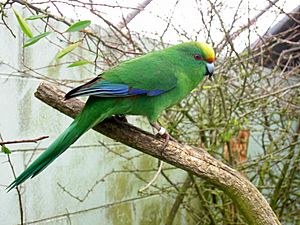Orange-fronted parakeet facts for kids

Cyanoramphus malherbi, usually known as the orange-fronted parakeet
Orange-fronted parakeet may refer to:
- Eupsittula canicularis, also known as the orange-fronted conure, or half-moon conure, a species of bird from Central America
- Cyanoramphus malherbi, also known as Malherbe's parakeet, or kākāriki karaka, a species of bird from New Zealand

All content from Kiddle encyclopedia articles (including the article images and facts) can be freely used under Attribution-ShareAlike license, unless stated otherwise. Cite this article:
Orange-fronted parakeet Facts for Kids. Kiddle Encyclopedia.